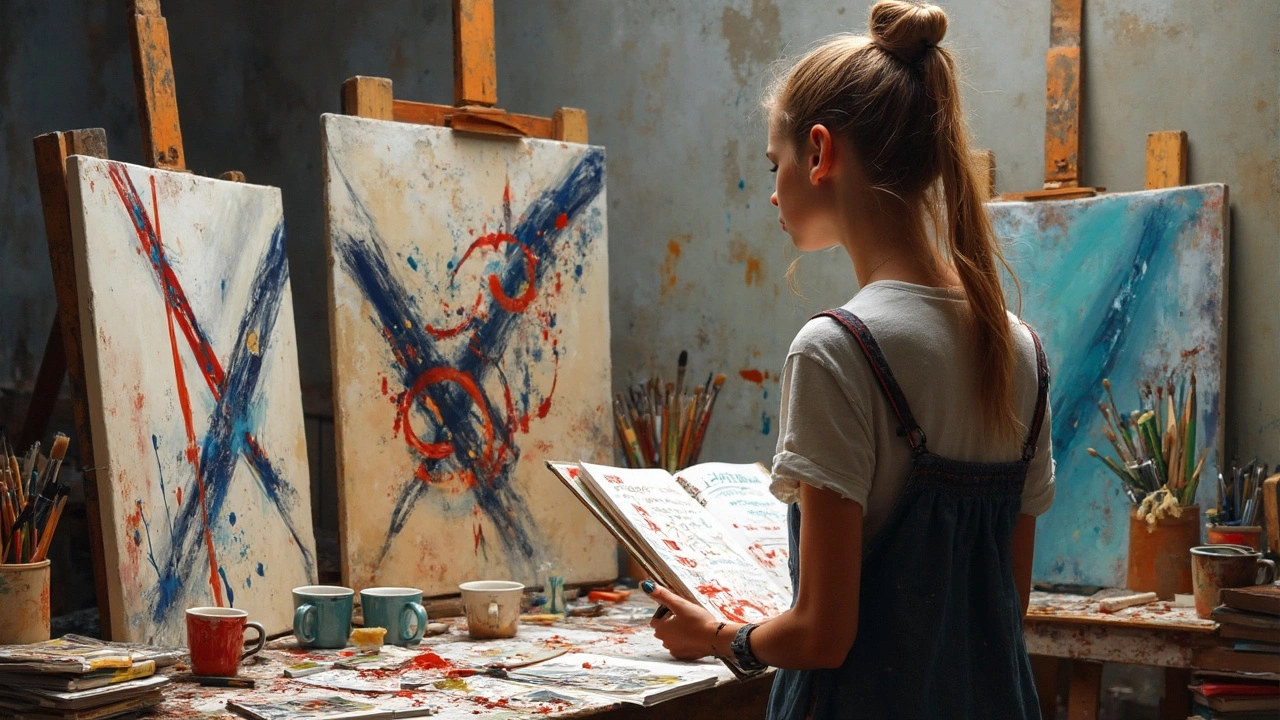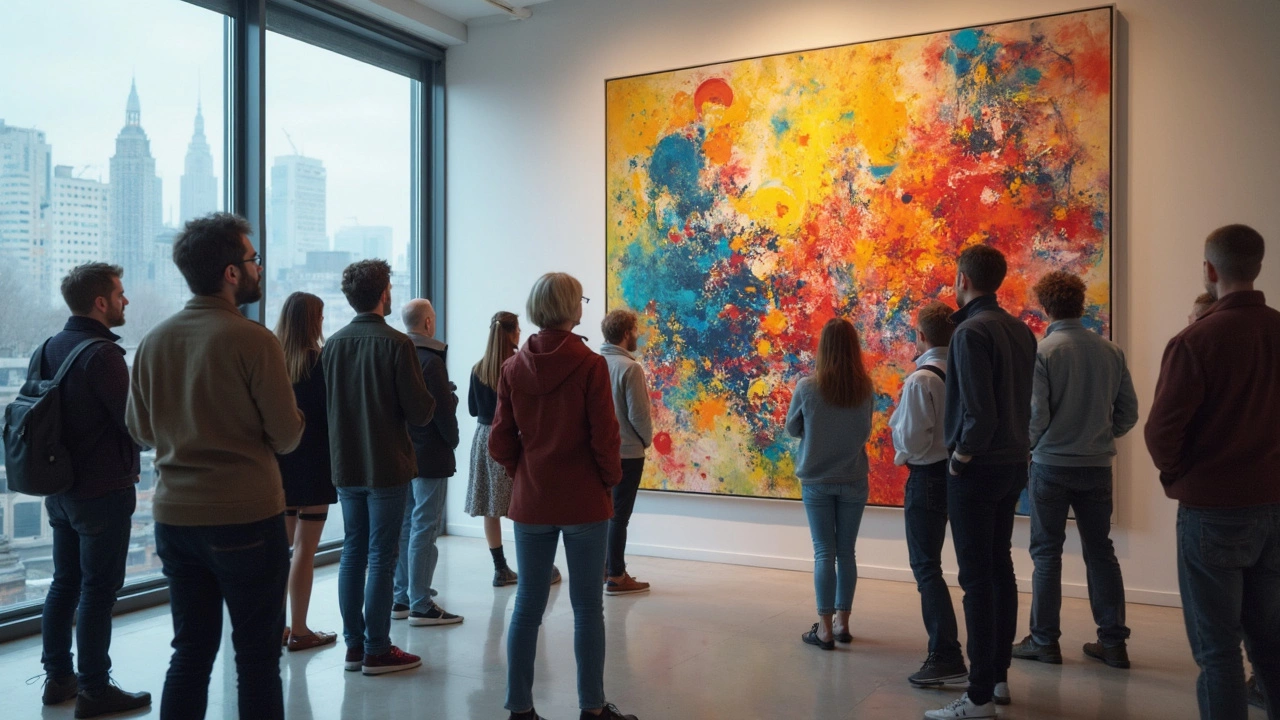Ever stared at a massive splash of color on a giant canvas and wondered, 'Am I missing something?' You’re not alone. Abstract art can feel like a test you didn’t study for, with shapes and patterns that look nothing like the real world. Most folks expect paintings to show people, trees, or at least something recognizable. Instead, they get blobs and messy lines.
The problem? Our brains are wired to spot patterns and make things fit. Abstract art shrugs at those rules. It doesn’t care if you see a face in the crowd—it wants you to look at color and movement instead. That’s why it can feel both frustrating and kind of freeing, depending on how you approach it.
Here’s what nobody tells you—it’s not about figuring out what it's 'supposed to be.' There’s no secret answer. Some of the greatest abstract artists, like Jackson Pollock or Wassily Kandinsky, actually wanted people to trust their feelings and reactions, not go hunting for hidden pictures or meanings. Once you let go of finding something familiar, abstract art starts to open up in surprising ways.
- Why Abstract Art Feels Like a Mystery
- What’s The Artist Really Doing?
- How to Decode Abstract Art: Practical Steps
- Making Abstract Art Work for You
Why Abstract Art Feels Like a Mystery
When you walk into a museum and spot a bold canvas covered in wild colors or strange shapes, it’s normal to feel lost. Abstract art just doesn’t follow the rules we expect. People are used to paintings of apples, starry skies, or portraits looking back at them. Abstract art flips that on its head. There are no familiar things to grab onto—it’s just color, space, and sometimes pure chaos.
One reason it feels so puzzling is history. For centuries, artists competed to paint the most realistic scenes possible. When abstract painters like Kazimir Malevich or Piet Mondrian showed up in the early 1900s, they ditched realism and left viewers scratching their heads. People didn’t know if they were missing the point or just staring at random doodles. Even today, about 1 in 3 museum visitors say they don’t understand modern or abstract art—and some will turn away after just fifteen seconds.
Another reason? Abstract art often dodges clear messages. With traditional paintings, you can usually guess what the artist is trying to say—a battlefield, a family, a bowl of fruit. But abstract artists want you to react instead of just analyze. They’re after something more personal—how you feel when you see a splash of red, or what memories come up when you look at swirling lines.
The mystery is made worse when people expect a "solution." With a puzzle, there’s a final answer. Abstract art just sits there, letting everyone make up their own mind. There’s no right or wrong way to see it, which is both freeing and confusing.
Here’s the kicker: some psychologists say that the brain actually works harder when looking at abstract art than realistic art. You’re wiring together new thoughts, making fresh connections, and engaging different emotions. Check out this quick snapshot:
| Type of Art | Brain Activation | Usual Reaction |
|---|---|---|
| Realistic | Pattern recognition, memory recall | Comfort, clear understanding |
| Abstract | Imagination, emotion, curiosity | Uncertainty, intrigue |
So, if you’ve ever felt confused looking at abstract art, you’re not alone—and your brain is actually working overtime! Give yourself some credit. It means you’re engaging, not failing.
What’s The Artist Really Doing?
It might look like artists just throw paint around when making abstract art, but most have a clear purpose. For example, Jackson Pollock didn’t randomly drip paint all over. He spent hours figuring out the movement and rhythm of each streak. Kandinsky once compared painting to composing music—think about how a song makes you feel without showing a picture. Artists like him pick colors and shapes to spark emotions or energy, even if the message isn’t obvious.
Abstract artists are focused on things you can’t always see, like feelings, moods, or even ideas. Take Mark Rothko: his giant blocks of color were meant to be stood in front of, almost like you’re soaking in the mood of the room. When you hear people say, “It’s about the experience,” this is what they mean.
Here’s a cool fact: In the early 1900s, artists started turning away from just painting things exactly as they looked. Cameras could do that job—why copy it? So, artists got more interested in what a painting could feel like instead of what it could show. They wanted to go beyond what you already see in your day-to-day life.
Some reasons artists go abstract:
- To let the viewer bring their own thoughts and imagination.
- To focus on color, texture, and shapes over objects.
- To show universal feelings like chaos, calm, or excitement without words.
- To experiment with new art materials or weird techniques.
If it helps, here’s a quick look at what drives a few well-known abstract artists:
| Artist | What They Wanted |
|---|---|
| Kandinsky | Connect music and color to emotions |
| Pollock | Capture energy and movement with action painting |
| Rothko | Make people feel something deep with color fields |
| Piet Mondrian | Show balance and harmony with simple lines and color blocks |
So, when you’re staring at a modern art painting and thinking, "What is going on?" remember: for a lot of artists, the goal isn’t to show you what a thing looks like—it’s to show you what it feels like. Next time, try to tune into your reaction instead of searching for a figure or story. You’ll probably get closer to what the artist was after.

How to Decode Abstract Art: Practical Steps
Trying to make sense of abstract art can be like looking at a puzzle with no box cover. But here’s the trick: you don’t need art history lessons or fancy degrees to get more out of it. Anyone can start decoding, even if you’ve never picked up a paintbrush.
If you want to get more out of modern or abstract art, start with these no-nonsense steps:
- Get Curious and Stay Open
- Forget the idea that there’s a right or wrong way to look at it.
- Pay attention to your first gut reaction. Do you feel excited, annoyed, confused? That’s actually part of the experience—abstract artists want real emotions, not fake art talk.
- Look for the Basics: Color, Shape, and Movement
- Break it down. Notice what stands out—big areas of red, wild lines, maybe a pattern hidden in the mess.
- Don’t try to find a horse in the clouds. Focus on how the colors interact, whether lines clash or flow, or if there’s a sense of energy or calm.
- Think About the Artist’s Choices
- Why did the artist go with a certain color or leave a space blank? Abstract artists like Mark Rothko obsessed over tiny color shifts because they believed color could make you feel intense emotions—even without pictures.
- Read the Wall Text (But Don’t Get Hung Up on It)
- Usually, museums put up a small sign or description. Take a look—it might tell you what was happening in the artist’s life or what inspired the work. Sometimes all you learn is a fancy name, but once in a while it adds real insight.
- Share Your Take
- If you’re with a friend, talk about what you see or feel. You might both spot something totally different. That’s normal. There are even studies showing people’s interpretations vary wildly—even among art students or experts.
If you want to geek out, here’s something interesting: according to a 2019 study published in the journal 'Psychology of Aesthetics, Creativity, and the Arts,' viewers who focused on the physical elements—like color and shape—reported enjoying abstract art more than those who tried to see representational forms. So, just noticing the basics can actually make the experience better.
The next time you find yourself lost in front of an abstract piece, just walk through these steps. Treat it more like a conversation than a math problem. The more you flex this muscle, the less weird abstract art will seem—and you might even start to love it.
Making Abstract Art Work for You
Abstract art doesn’t need to be intimidating or confusing. Believe it or not, you can make it work for you, whether you’re staring at a canvas in a museum or picking a print for your living room. Here’s how you can get more out of abstract art with just a few tweaks in how you look at it.
- Drop the pressure to “get it.” There’s no magic code or right answer with abstract art. Instead of overthinking it, ask yourself: How does this make me feel? A little weird, relaxed, energized? That’s your real reaction, and it counts.
- Look for elements you connect with. Forget searching for hidden objects. Instead, try focusing on a specific color, line, or texture. Studies show colors alone influence emotions—a fact the advertising world uses all the time. Abstract artists mess with this on purpose.
- Mix up how you interact with the artwork. Stand close, then back up. Tilt your head. Take a photo, zoom in. Sometimes, things pop out when you look at them differently.
- Read the placard or artist’s notes, but don’t rely on them. A fact: Not all artists care about viewers “getting” their intent. Some, like Mark Rothko, just want you to spend time with the piece and see what happens.
You might be surprised to learn that in 2023, a survey by the Art Institute of Chicago found most visitors to the abstract gallery spent just 18 seconds per artwork. Want to get more out of your visit? Slow down—give it at least 60 seconds. Chances are you’ll notice something new, and those weird blobs start telling a story unique to you.
| Tip | Why It Helps |
|---|---|
| Take your time | Slower viewing opens up new details and feelings |
| Share your thoughts with a friend | Different eyes catch different things |
| Don’t compare to other art forms | Abstract art stands on its own |
At home, try swapping that print you bought for the colors with something a little more daring. Hang it, live with it, and notice if your mood or the space changes. Abstract art is supposed to create a conversation—sometimes with just yourself. That’s the fun part.

